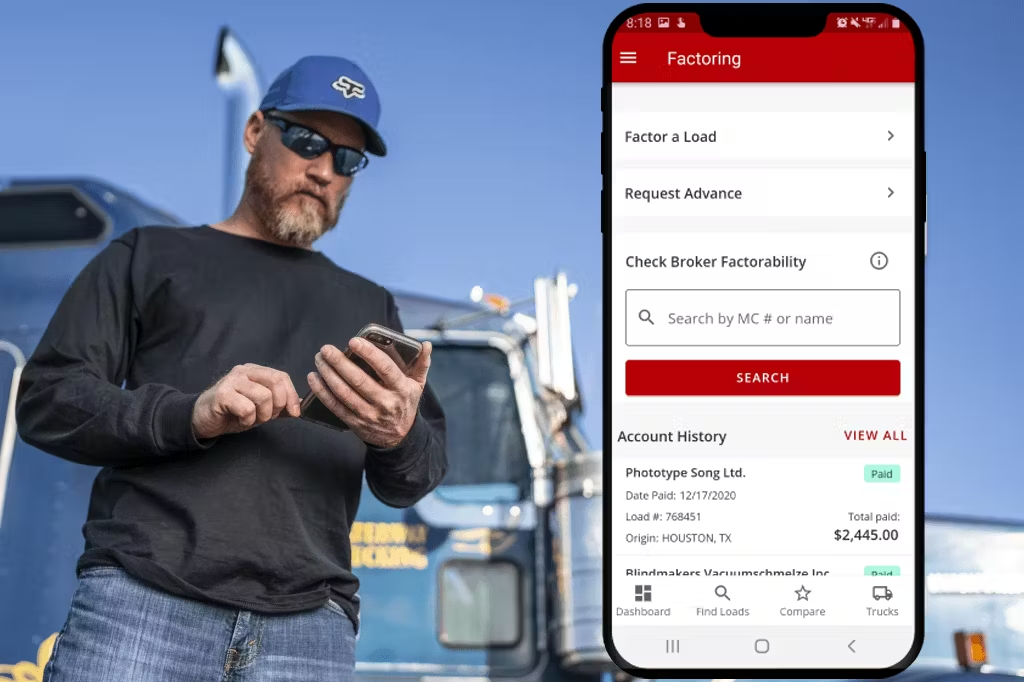Truck Driver Salary: Top Paying Jobs (By State & Freight Type)

What are you waiting for?
Make more money starting now.
No matter how much you might love being on the road, very few people get into a career without the expectation of making money. What is the average annual truck driver salary? As it turns out, the differences in truck driver salaries can be immense. How much you make each year depends on various factors, from the certifications you hold to where you live and even the types of freight you carry. Let’s break down what goes into truck driver pay to show you what to expect.
Average salaries of a truck driver
It’s hard to figure out the average base salary of a truck driver nationwide because it depends heavily on so many different factors. But PayScale.com notes that across all types of commercial trucking and all experience levels, the nationwide average truck driver’s salary is $20.49 per hour. This rises with more years of experience and the type of freight. For example, HAZMAT (hazardous materials) drivers earn an average of 34% more. OTR (over the road) drivers also make more than regional drivers, at an average of $56,818 per year. Bonuses are not included in these national average rates. The Bureau of Labor Statistics has similar numbers, with the average pay for tractor-trailer drivers listed at $22.66 per hour across all geographic locations and years of experience.
New vs. experienced truck driver salaries
Naturally, new truck drivers make less money than those with experience, assuming all other factors are equal. The average brand-new truck driver with less than one year of experience will make about $20.49 an hour, according to PayScale.com. This lower wage is actually training pay in many cases, as many drivers choose to go through a truck driving school for training and licensure. Most schools pay a flat, relatively low weekly rate to their driver trainees. Once you are fully trained and licensed, your actual pay will depend on where you get a job or whether you become an independent owner-operator.
Generally speaking, experienced truck drivers make more than average, especially those who earn certifications. With some skill and ingenuity, you could be making real money in a few years. You can also find ways to increase your total pay, from taking mileage-based rather than hourly jobs to stacking up bonuses.
CDL vs. non-CDL truck driver salaries
Technically, you need a CDL (commercial driver’s license) for any trucking job. While some trucking companies might hire drivers for certain jobs with just a regular driver’s license, it’s generally not recommended. If an accident or anything else happens, the Department of Transportation (DOT) will look closely at whether you should have had a CDL to perform the job legally. If they determine you should have, the penalties can be stiff.
Even if you never have an incident, though, don’t expect a non-CDL job to pay well. CDL truck driver salaries are significantly higher, even in the early years of your career. It’s easy enough to go through truck driving school, earn your license, and become eligible for well-paid, perfectly legal, CDL trucking jobs. In many cases, you won’t even need to pay upfront.
OTR truck driver salaries
OTR trucking is what many people think of as traditional truck driving. OTR drivers work alone or in two-person teams to cover long distances and are often on the road for up to four weeks at a time. Depending on the specific equipment they will operate, OTR truckers need a Class A, B, or C CDL license. You can also earn a HAZMAT (hazardous materials) endorsement, which pays more. A typical OTR truck driver salary is based on mileage (listed as CPM or cost per mile) and bonuses.
You can make a good living as an OTR truck driver, but make sure you know what can eat into your paycheck. In particular, pay attention to federally mandated hours of service limitations that affect how much you can drive in a day and a week. Also, look into the impact of delays (known as “detentions” in the trucking industry). Even weather conditions and poor road maintenance can affect how much you ultimately make.
Owner-operator salaries
Becoming an owner-operator can be one of the best ways to make a significant income as a truck driver. According to Indeed.com, the average owner-operator salary is about $290,000 per year. But there are some catches. How much you make will depend entirely on how much you bring in (revenue) versus spending (expenses).
Owner-operators have overhead expenses that include everything from purchasing or leasing your truck (and annual maintenance costs) to fuel costs, insurance, and, of course, taxes. Meanwhile, you’ll be responsible for finding your own customers (including paying customer acquisition costs) and negotiating your own rates. There are several tips and tricks for maximizing your revenue while minimizing your expenses, but the bottom line is that all the responsibility falls on you. This can be a good thing or a bad thing, depending on your personality and sales skills.
Small vs. large company trucking salaries
There is no clear-cut difference in pay between small companies and large companies. But there are some things to think about when deciding which type of trucking company you want to work for.
Small employers typically don’t have as much discretionary income to pay drivers. Some might also be more likely to ask drivers to work as independent contractors, which shifts the entire tax burden to the driver. But smaller companies that are actively growing also tend to invest every penny they can into developing their drivers. You’ll generally have better access to senior management and even owners in those cases. You might also have more flexibility or the opportunity to contribute ideas to help the company grow.
Large companies generally have plenty of discretionary funds. But what they do with them varies according to each company’s values. Some set standard truck driver salary bands and offer raises based on experience and certifications, which can be highly competitive. They might also offer free or deferred-payment training programs, clear paths to management, and relocation opportunities. On the other hand, some big companies also pay lower rates, provide less training, and can experience very high turnover. Figure out which priorities matter most for your particular goals.
When looking for a truck driver position, choose a company with an excellent reputation known for its safety record and commitment to its drivers, no matter the size.

Highest income potential for truck drivers (by state)
Like any other career field, truck driver salaries can vary according to supply and demand. So the top-paying state this year might not be the top-paying state next year. In addition, exactly what you’ll make depends heavily on the specific company you work for, the type of pay agreement (hourly vs. mileage), bonuses, and the equipment you use. Still, some states tend to pay higher than others even after accounting for those factors. So if you’re looking to relocate, you might consider one of these states, which the Bureau of Labor Statistics ranked as paying the highest salary ranges in 2021:
- Washington
- District of Columbia
- Alaska
- New Jersey
- New York
Other typically high-paying states include:
- Colorado
- Illinois
- Massachusetts
- Minnesota
- Nebraska
- North Dakota
- Wyoming
Highest income potential for truck drivers (by freight type)
One of the most significant determining factors in how much truck drivers make is the type of freight they haul. Here is a deeper look at the different kinds of cargo and the rates you can expect.
LTL
LTL, or less than truckload freight, refers to shipments that are not large enough to fill the truck. Traditional LTL has no minimum size requirements. Volume LTL must consist of at least six pallets, measure between 12 and 32-cubic-feet in size, and weigh at least 5,000 pounds. The carrier then combines these smaller loads from multiple shippers to create a full truckload. Truck drivers can use both to fill their trucks and reduce deadhead miles. You can view the latest LTL rates on the Truckstop Less Than Truckload Load Board.
Flatbed
Flatbed truck drivers tow flat, open trailers rather than traditional enclosed trailers. These are great for hauling oddly shaped or sized items, but they add extra challenges for the driver. You’ll need to ensure the load is secured and protected from adverse weather. These additional tasks call for a specific skill set and can result in higher pay. To see the most current rates for flatbed loads, visit the Truckstop Flatbed Load Board.
Dry van
Dry van trailers are rolling boxes with no climate control. They’re typically 48-53 feet long, though there are also shorter 28-foot trailers. Shippers choose economical dry van shipping for nonperishable goods, from liquor to healthcare equipment to auto parts. There’s usually a huge supply of dry van loads. Check Truckstop’s Dry Van Load Board for availability and current rates.
Reefer
A reefer is a refrigerated trailer used to transport perishable goods that must be kept cold or frozen, such as milk, meat, or certain pharmaceuticals. Because the cooling system must be kept in top operational shape, reefer trucks can be more complicated to maintain than dry vans. But this can also mean higher pay. See the latest reefer rates on the Truckstop Refrigerated Load Board.
Heavy haul
Heavy haul loads consist of overweight and/or oversized items, such as aircraft parts or heavy-duty military hardware. You’ll need specialized equipment to haul these loads and additional licensing or certifications. You might also need to coordinate with multiple professionals to design safe routes, arrange for escort vehicles, or temporarily lift power lines. Heavy haul trucking generally pays well to account for these extra tasks. Find the most updated rates on the Truckstop Heavy Haul Load Board.
Hot shot
Hot shot truckers deliver small, time-sensitive loads. Unlike expedited shipping, hot shot truckers don’t keep trucks on standby for these loads but instead use load boards to find jobs when they have the time. Hot shot rates can be pretty high because shippers are often willing to pay more to deliver materials quickly. Find out how much hot shot loads are paying on the Truckstop Hot Shot Load Board.
Truck driver bonuses
Trucker driver salaries typically break down into three parts. Base pay is the hourly or per-mile fee for hauling a load. You might also get specialized pay for detention (delays from a shipper or receiver) or layovers when your truck sits idle with no load. Many truck drivers make their real money in bonuses. Here are some of the most common bonuses:
Sign-on
The trucking business is competitive, and growing carriers constantly need to hire new drivers. To attract the best talent, carriers often offer sign-on bonuses for their new drivers. These might be paid as a lump sum or divided across several weeks or months of paychecks.
Monthly mileage
Though it’s by no means universal throughout the industry, many carriers like to reward their top performers. Find out if your company has a monthly mileage bonus that you can earn for driving a certain number of miles in a month.
Safety
Safe driving is paramount for most carriers and some reward drivers with proven safety records. You might need to drive a certain number of miles, or a specific number of weeks, with no incidents.
Fuel efficiency
Semi-trucks burn a lot of fuel, and cost-conscious carriers try to minimize fuel expenses. Ask whether your company offers a fuel efficiency bonus and what records you need to keep to prove you’re reducing consumption.
DOT inspections
The Department of Transportation (DOT) conducts annual truck and driver inspections, including checking your daily logs to examine the equipment. If you have a clean inspection, some carriers reward that with a cash bonus.
Referrals
Many carriers know that referrals are one of the best ways to recruit trustworthy, qualified new drivers. In many cases, carriers pay referral bonuses to drivers who enlist a friend. There are usually conditions, like the length of time the new referral must work for the company before getting the bonus.
How to increase trucker salaries
Now you know the factors that go into how much truck drivers make. How can you put it all together to boost your salary? Here are some of the top ways to raise your income as a trucker.
1. Become an owner-operator.
Owner-operators often make more money than company drivers, but that freedom also brings additional risk. If you’re ready to take the plunge, check out our 15-step guide to success as an owner-operator.
2. Keep your truck fully loaded.
The fuller your truck, the more money you’ll make. Don’t hesitate to use LTL and hot shot loads to keep your truck full and moving. When possible, negotiate layover and detention pay to minimize your losses during delays.
3. Get a HAZMAT endorsement.
It’s not that hard to get a HAZMAT (hazardous materials) endorsement. It lets you carry more dangerous loads, often at a higher pay rate. You’ll need to submit an application, fingerprints, and identity documents for a background check. When you’re cleared, take the endorsement test at your local DMV.
4. Haul oversized loads.
If you’re willing to deal with permitting and route planning, oversized loads are a great way to bump your pay. But be sure you’re following all the relevant laws and guidelines, which might differ by jurisdiction.
5. Try ice road trucking.
Do you have a sense of adventure? Top-notch truck driving skills in extreme conditions? Ice road trucking is a dangerous job, but it pays well for a short season (typically January through March). Most U.S.-based ice road truckers work in Alaska or parts of Canada.

6. Get paid faster with factoring.
With tools like Truckstop Factoring, there’s no more waiting 30-45 days (or more!) to get paid for a load you already hauled. Submit your invoice to us. We’ll verify it and pay you within 24 hours for a small fee. Your broker will reimburse us. Best of all: You get paid even if your broker can’t pay us.
Find and book the highest-paying truck loads.
Are you ready to access the highest-paying truck loads? At Truckstop, we make it simple with our comprehensive Load Board for Carriers. Find loads, search current rates, and make the connections you need to keep your truck filled and moving. Get started today.
Get helpful content delivered to your inbox.
Sign up today.
Find high-quality loads fast, get higher rates on every haul, and access tools that make your job easier at every turn.






